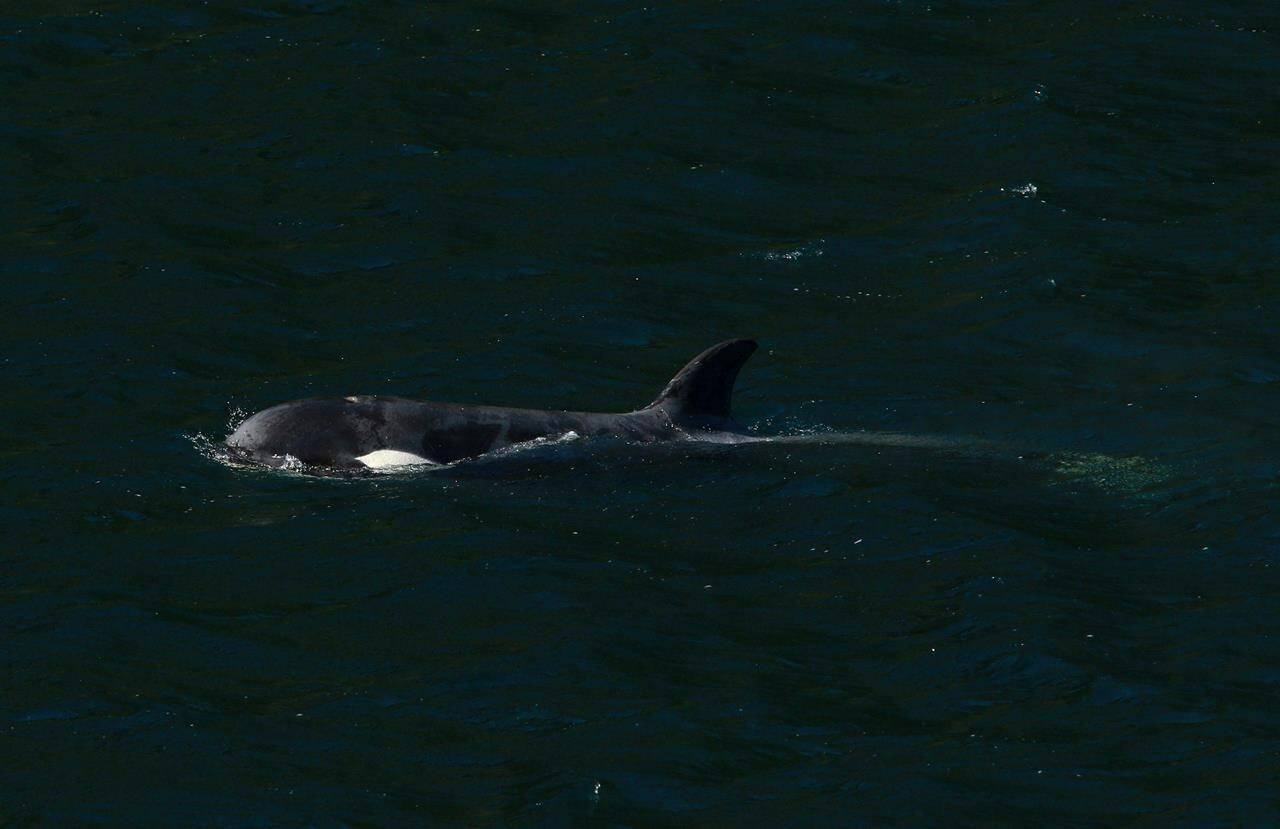A killer whale calf made her own bid for freedom Friday for a potential reunion with extended family in the nearby ocean, swimming under a bridge at high tide and out of a remote Vancouver Island lagoon where she had been trapped for more than a month.
The orca has been the focus of intense rescue efforts since March 23 when her pregnant mother became stranded on a rocky beach and died near the bridge in the small inlet next to the community of Zeballos, B.C.
The Ehattesaht and Nuchatlaht First Nations say in a statement the calf chose a “clear and glass-calm, star-filled night” at about 2:30 a.m. to swim under the bridge and down the inlet.
READ MORE: Orphaned orca calf swims out of B.C. lagoon after being trapped for weeks
“I’m very happy,” Ehattesaht First Nation Chief Simon John said in an interview Friday. “It is a moment in time basically to be happy and I think it’s really a good time.”
The orca calf, estimated to be about two years old, was seen breaching and playing near the bridge end of the lagoon for much of Thursday evening, but only a few people were there to witness her escape as she swam under the bridge, he said.
“My daughter Ashley was there,” John said. “She was really happy. It was like three in the morning by the time she had actually gone to the other side and they went to meet her on the other side in the zodiac.”
The calf the First Nations named kwiisahi?is, or Brave Little Hunter, started eating seal meat provided by the nations last week, giving rescuers hope they could entice the young killer whale to follow a food trail out of the lagoon.
A large rescue team made up of Indigenous leaders, Fisheries Department marine mammal experts, Vancouver Aquarium veterinarians, commercial fishermen, divers and drone operators abruptly stopped a planned capture last week when the orca began eating seal meat thrown to her. She was also seen catching herring in the lagoon.
A Fisheries Department statement Friday said members of the Nuchatlaht and Ehattesaht First Nations, who were in a small inflatable vessel, were able to entice the killer whale calf to exit the lagoon by tossing her sea lion meat.
The team was planning last week to launch its second attempt to capture the calf with a large net, then place her in a sling for transport in a specially outfitted vehicle to the ocean where she could be released and potentially reunited with her extended family.
“I think she’s really healthy,” said John. “There’s a lot of footage out there of her being happy around the bridge area.”
The statement from the nations said rescue team members are “ecstatic,” that the orca was moving out of Little Espinosa Inlet and into Espernaza Inlet, which leads to the open ocean.
“They will encourage her out toward the open ocean where it is hoped that the Brave Little Hunter’s calls will now be heard by her family,” said the Ehattesaht statement. “Today, the community of Zeballos and people everywhere are waking up to some incredible news and what can only be described as pride for strength this little orca has shown.”
The Fisheries Department said members of its marine mammal rescue team were stationed at the lagoon entrance much of the night to ensure the young killer whale did not become stranded during the approaching low tide.
At 7:18 a.m. Friday morning, “the calf was found in Espinosa Inlet, moving toward Esperanza Inlet proper,” said the statement. “The team is now working to encourage kwiisahi?is toward open ocean water.”
The statement said the Fisheries Department will work with First Nations, whale watchers, researchers and boaters to monitor the location of the orca calf’s extended Bigg’s killer whale family.
The last reported sighting of Bigg’s killer whales was more than two weeks ago in the Barkley Sound area, southwest of Zeballos, near Ucluelet.
“The team will also be monitoring the location of the calf while she seeks out her family,” the statement said.
Zeballos, located more than 450 kilometres northwest of Victoria, is a remote community of about 200 people.
The First Nations’ statement said the rescue has now entered a new phase and patrol and protective measures will be taken in the area to ensure the young orca has no contact with boats or people.
“With this part of the challenge solved by kwiisahi?is herself, every opportunity needs to be afforded to have her back with her family with as little human interaction as possible,” the Ehattesaht said.
Marine mammal experts and independent whale scientists have said the young orca’s chances of survival in the open ocean and reuniting with extended family members are good.
The First Nations’ statement said Indigenous people across Canada are writing new stories in these modern times, reinforcing their deep connections between the spirit world, the animal world and the people who have remained on the land and waters.
“Events like these have a deeper meaning and the timing of her departure will be thought about, talked about and felt for generations to come,” the statement said.
John said the orca’s departure from the lagoon is bittersweet for him as it comes on the anniversary of his daughter Kayla’s violent death 20 years ago.
“Really, for me, today is the anniversary of my daughter’s death, so I’m just trying to maintain myself currently,” he said. “It’s been a tough process for me certainly with the whale thing coming after 20 years today. It’s kind of significant to me. Nobody has to own it but me.”
— By Dirk Meissner in Victoria
The Canadian Press

